All Posts (6434)
 The answer to the question is yes. What is not told is that the various sovereignty/ National groups are like the various political parties within the USA. Each have their own agenda and platform yet they recognize themselves as citizens of their country. This is ongoing here in Hawaii as well.We know that the Hawaiian Kingdom still exists albeit under the unlawful belligerent occupation of the United States of America. Everyone wants to restart the Hawaiian Kingdom. This is good! The ipso facto State and the ipso facto Federal Government are afraid that we will. Thus, through the corporate medias and the seditous school systems, they have constantly belittled the Hawaii Nationals and obfuscate the issues and facts hoping we wouldn't wise up.Let's look at the pertinent facts:* The Kingdom of Hawaii was created by King Kamehameha and stylized to conform with the international related countries.* Kamehameha, Ka'ahumanu, and Vancouver became fast friends whereby the king pick the brains of the Englishman who was a great help in setting the king's course toward international recognition.* Armed with the knowledge Ka'ahumanu gained through this liason with Vancouver, after the King died and the missionaries arrived, she had done a coup d'etat to then become Kuhina Nui. She chose to use the missionaries and chiefs for her own agenda and continue to put the islands on par with the other known countries.* Kauikeaouli was counselled by the Queens who swayed the power of the Kingdom to keep it toward its goal. He, after his brother's reign, took charge of the Kingdom. He and his chiefs commissioned William Richards to instruct them according to the Wayland's book, Elements of Political Economy.* Hawaiians were quick learners and utlized their new-found knowledge on how to deal with foreign countries and develop theirs to conform with the powers of the world. In doing so, the King chose to reform his national government and give up his absolute rule to a constitutional monarchy.* In 1839 the Hawaiian Magna Carta was created and a constitution was promulgated. Treaties with other countries were ratified and subject to the supreme law of the land.* The French and the British signed a proclamation of recognizing the Independence of the Hawaiian Kingdom as a nation-state and it was the move to join the Family of Nations. The US followed suit and recognized the nation-state of Hawaii. Through the efforts of Hawaii's subsequent monarchs, over 25 treaties with countries around the world were secured and by 1893, there were over 96 consuls and legations throughout the world.* Kalakaua, succeeded in securing relations with countries around the world and the Kingdom became the richest per capita globally as well as one of the most modern. Hawaii actively participated internationally as part of the Family of Nations, predessessor of the League of Nations which evolved to the United Nations. Hawaii's status of neutrality was also recognized as that of Switzerland.* The USA was trying to find a way to control Hawaii or takeover the islands with the people voluntarily wanting to join it since 1826. Because of the fast actions of the King; the USA could not take it without the people's consent or it would set a precedent violating international laws. The covert actions of the USA began to spin.* US President Harrison and Secy of State James Blaine colluded with Lorrin Thurston to destabilze the Hawaiian Kingdom and conspired to have John L. Stevens to assist by creating a fake revolution without setting an international precedent. In 1887 the US Americans under Thurston and his cohorts staged a coupe, the first overt action to wrest the kingdom from the King and forced him to sign the Bayonet Constitution. It was done between the years that legislation was not in session. Thus, it was never ratified but implied.* Only Stevens and his troops and the Committee of Safety was aware of what was transpiring. On the steps of a government building, the proclamation was read under the protection of the US troops and immediately Stevens recognized the Committee of Safety's Provisional Government as the lawful government. They had never had control of the police station, government buildings, palace, and barracks. The troops remained to protect and secure the US puppet government.* The Queen surrendered to the USA rather than to those scurrilous US American complicitous traitors; with hopes that upon learning the truth, the USA would restore her to her throne and reinstate her government.*The Ku'e Petions were signed by over 96% of the multi-ethnic Hawaii Nationals in 1897; all loyal to the Queen and her government in protest of the invasion and against annexation. Annexation attempt twice failed in the US. Spanish-American war began and Mckinley opted for the Newlands Resolution to annex hawaii.* So we have the "bible-plow-rifle" in which the US gained control of Hawaii. A resolution is a domestic law which has no juridiction within another country. There was no treaty of annexation; hence, the annexation is illegal, null and void.* The US belligerent occupation of the Hawaiian Kingdom is ongoing till today. The US has violated the laws of occupation and disregards Hawaii's neutrality. The Statehood act is another process greatly flawed and deemed null and void. The impropriety in the process is there was no international observance to validate the process; US Americans could vote; the question was to remain a territory or become a state and omitted the other choices. Only 22% of eligible voters cast their ballot and 94% of them voted for statehood.To summarize, the descendants of the original Hawaii Nationals are still Hawaii Nationals and the Hawaiian Kingdom still exists. The only logical consequence is total independence and the USA must de-occupy our country. OHA, an agency of the ipso facto State which is a part of the USA, is trying to comply and promote the Akaka Bill using the Kau Inoa census to support it. In the meantime, this US entity, wants to create a US puppet governing tribal entity to fit into the US system to appear as a nation within a nation by usurping the authority and jurisdiction of the existing Hawaiian Kingdom. History is repeating itself in the neo-provisional government OHA intends to establish and call it a restoration of which it isn't. When one owns the entire pie; why would one give it away to accept the crumbs in return? Knowing who you really are; empowers you.He Hawai'i au; a o 'oe?
The answer to the question is yes. What is not told is that the various sovereignty/ National groups are like the various political parties within the USA. Each have their own agenda and platform yet they recognize themselves as citizens of their country. This is ongoing here in Hawaii as well.We know that the Hawaiian Kingdom still exists albeit under the unlawful belligerent occupation of the United States of America. Everyone wants to restart the Hawaiian Kingdom. This is good! The ipso facto State and the ipso facto Federal Government are afraid that we will. Thus, through the corporate medias and the seditous school systems, they have constantly belittled the Hawaii Nationals and obfuscate the issues and facts hoping we wouldn't wise up.Let's look at the pertinent facts:* The Kingdom of Hawaii was created by King Kamehameha and stylized to conform with the international related countries.* Kamehameha, Ka'ahumanu, and Vancouver became fast friends whereby the king pick the brains of the Englishman who was a great help in setting the king's course toward international recognition.* Armed with the knowledge Ka'ahumanu gained through this liason with Vancouver, after the King died and the missionaries arrived, she had done a coup d'etat to then become Kuhina Nui. She chose to use the missionaries and chiefs for her own agenda and continue to put the islands on par with the other known countries.* Kauikeaouli was counselled by the Queens who swayed the power of the Kingdom to keep it toward its goal. He, after his brother's reign, took charge of the Kingdom. He and his chiefs commissioned William Richards to instruct them according to the Wayland's book, Elements of Political Economy.* Hawaiians were quick learners and utlized their new-found knowledge on how to deal with foreign countries and develop theirs to conform with the powers of the world. In doing so, the King chose to reform his national government and give up his absolute rule to a constitutional monarchy.* In 1839 the Hawaiian Magna Carta was created and a constitution was promulgated. Treaties with other countries were ratified and subject to the supreme law of the land.* The French and the British signed a proclamation of recognizing the Independence of the Hawaiian Kingdom as a nation-state and it was the move to join the Family of Nations. The US followed suit and recognized the nation-state of Hawaii. Through the efforts of Hawaii's subsequent monarchs, over 25 treaties with countries around the world were secured and by 1893, there were over 96 consuls and legations throughout the world.* Kalakaua, succeeded in securing relations with countries around the world and the Kingdom became the richest per capita globally as well as one of the most modern. Hawaii actively participated internationally as part of the Family of Nations, predessessor of the League of Nations which evolved to the United Nations. Hawaii's status of neutrality was also recognized as that of Switzerland.* The USA was trying to find a way to control Hawaii or takeover the islands with the people voluntarily wanting to join it since 1826. Because of the fast actions of the King; the USA could not take it without the people's consent or it would set a precedent violating international laws. The covert actions of the USA began to spin.* US President Harrison and Secy of State James Blaine colluded with Lorrin Thurston to destabilze the Hawaiian Kingdom and conspired to have John L. Stevens to assist by creating a fake revolution without setting an international precedent. In 1887 the US Americans under Thurston and his cohorts staged a coupe, the first overt action to wrest the kingdom from the King and forced him to sign the Bayonet Constitution. It was done between the years that legislation was not in session. Thus, it was never ratified but implied.* Only Stevens and his troops and the Committee of Safety was aware of what was transpiring. On the steps of a government building, the proclamation was read under the protection of the US troops and immediately Stevens recognized the Committee of Safety's Provisional Government as the lawful government. They had never had control of the police station, government buildings, palace, and barracks. The troops remained to protect and secure the US puppet government.* The Queen surrendered to the USA rather than to those scurrilous US American complicitous traitors; with hopes that upon learning the truth, the USA would restore her to her throne and reinstate her government.*The Ku'e Petions were signed by over 96% of the multi-ethnic Hawaii Nationals in 1897; all loyal to the Queen and her government in protest of the invasion and against annexation. Annexation attempt twice failed in the US. Spanish-American war began and Mckinley opted for the Newlands Resolution to annex hawaii.* So we have the "bible-plow-rifle" in which the US gained control of Hawaii. A resolution is a domestic law which has no juridiction within another country. There was no treaty of annexation; hence, the annexation is illegal, null and void.* The US belligerent occupation of the Hawaiian Kingdom is ongoing till today. The US has violated the laws of occupation and disregards Hawaii's neutrality. The Statehood act is another process greatly flawed and deemed null and void. The impropriety in the process is there was no international observance to validate the process; US Americans could vote; the question was to remain a territory or become a state and omitted the other choices. Only 22% of eligible voters cast their ballot and 94% of them voted for statehood.To summarize, the descendants of the original Hawaii Nationals are still Hawaii Nationals and the Hawaiian Kingdom still exists. The only logical consequence is total independence and the USA must de-occupy our country. OHA, an agency of the ipso facto State which is a part of the USA, is trying to comply and promote the Akaka Bill using the Kau Inoa census to support it. In the meantime, this US entity, wants to create a US puppet governing tribal entity to fit into the US system to appear as a nation within a nation by usurping the authority and jurisdiction of the existing Hawaiian Kingdom. History is repeating itself in the neo-provisional government OHA intends to establish and call it a restoration of which it isn't. When one owns the entire pie; why would one give it away to accept the crumbs in return? Knowing who you really are; empowers you.He Hawai'i au; a o 'oe?
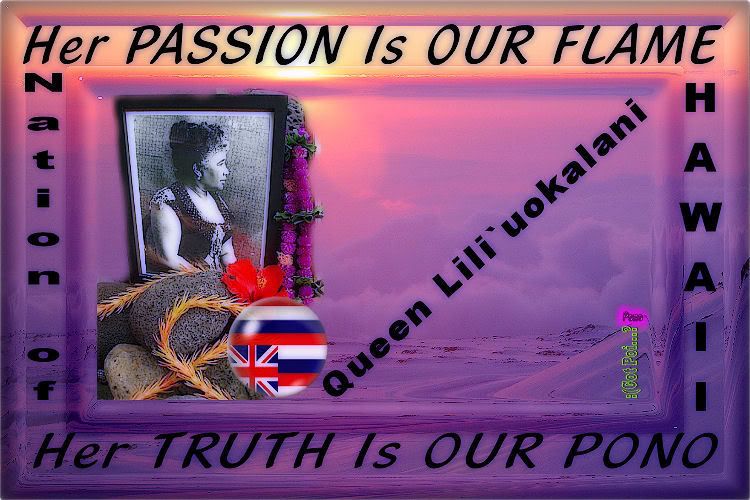



 Aloha peace Ohana,Please call Hawaii County Mayor Harry Kim 961-8211Hawaii County Council members 961-8225State legislators and Hawaii's Congresspeopleand urge action as called for in the open letter below. MahaloMalu `Aina Center for Non-violent Education & ActionP.O. Box AB Ola`a (Kurtistown), Hawaii 96760Phone 808-966-7622 email ja@interpac.net www.malu-aina.orgAN OPEN LETTER TO COUNTY OF HAWAII MAYOR HARRY KIMAloha Mayor Kim: March 3, 2008This is an urgent appeal for you to take immediate action to stop the spread of radiation contamination at the military's 133,000-acre Pohakuloa Training Area (PTA) in the center of Hawaii Island. You are aware that on August 20, 2007, the Army confirmed the presence of radiation from weapons training at PTA. Presently, the full extent of the contamination is not known due to the massive size of the range, incomplete testing, and poor record-keeping by the military. Given the fact that all branches of the military have trained at PTA for more than 50 years, the history of the military lying on such things as secret nerve-gas testing in the Hilo watershed, and stonewalling other public concerns in Hawaii, it is reasonable to believe that the extent of radiation contamination at PTA is far more than we are being told.Currently, live-fire training by 2,000 Marines is taking place at PTA, including the use of big cannons. More live-fire training by the U.S. Army is planned following the Marines' training. Such actions risk spreading the radiation contamination at PTA.We urge you to speak out publicly and urge other elected officials and political candidates to join you in calling for the following action: All live-fire and aerial bombings of the entire Pohakuloa range should be immediately stopped until a thorough, objective and independent survey has been funded (via the military budget) and completed, in order to assure real public safety.Hawaii, is a rare jewel of the planet, a true paradise on earth, of unmatched natural beauty. And now it is being poisoned. Mayor Kim, this is your day in the sun. Please do the right thing for the people of Hawaii and for all the world. Speak out to stop this reckless endangering by the U.S. military. Some scientists say that radiation contamination is one of the major issues of our lifetime, one of the greatest challenges facing civilization today.We look forward to your positive actions. Mahalo and aloha..Jim Albertini, Daniel H.C. Li, Galen and L.V. Kelly, Paul W. Normannfor Malu `AinaKale Gumapacfor the Kanaka Councilcc: elected officials and political candidatesnews media
Aloha peace Ohana,Please call Hawaii County Mayor Harry Kim 961-8211Hawaii County Council members 961-8225State legislators and Hawaii's Congresspeopleand urge action as called for in the open letter below. MahaloMalu `Aina Center for Non-violent Education & ActionP.O. Box AB Ola`a (Kurtistown), Hawaii 96760Phone 808-966-7622 email ja@interpac.net www.malu-aina.orgAN OPEN LETTER TO COUNTY OF HAWAII MAYOR HARRY KIMAloha Mayor Kim: March 3, 2008This is an urgent appeal for you to take immediate action to stop the spread of radiation contamination at the military's 133,000-acre Pohakuloa Training Area (PTA) in the center of Hawaii Island. You are aware that on August 20, 2007, the Army confirmed the presence of radiation from weapons training at PTA. Presently, the full extent of the contamination is not known due to the massive size of the range, incomplete testing, and poor record-keeping by the military. Given the fact that all branches of the military have trained at PTA for more than 50 years, the history of the military lying on such things as secret nerve-gas testing in the Hilo watershed, and stonewalling other public concerns in Hawaii, it is reasonable to believe that the extent of radiation contamination at PTA is far more than we are being told.Currently, live-fire training by 2,000 Marines is taking place at PTA, including the use of big cannons. More live-fire training by the U.S. Army is planned following the Marines' training. Such actions risk spreading the radiation contamination at PTA.We urge you to speak out publicly and urge other elected officials and political candidates to join you in calling for the following action: All live-fire and aerial bombings of the entire Pohakuloa range should be immediately stopped until a thorough, objective and independent survey has been funded (via the military budget) and completed, in order to assure real public safety.Hawaii, is a rare jewel of the planet, a true paradise on earth, of unmatched natural beauty. And now it is being poisoned. Mayor Kim, this is your day in the sun. Please do the right thing for the people of Hawaii and for all the world. Speak out to stop this reckless endangering by the U.S. military. Some scientists say that radiation contamination is one of the major issues of our lifetime, one of the greatest challenges facing civilization today.We look forward to your positive actions. Mahalo and aloha..Jim Albertini, Daniel H.C. Li, Galen and L.V. Kelly, Paul W. Normannfor Malu `AinaKale Gumapacfor the Kanaka Councilcc: elected officials and political candidatesnews mediaJim Albertini
Malu `Aina Center For Non-violent Education & Action
P.O. Box AB
`Ola`a (Kurtistown), Hawaii 96760
Phone 808-966-7622
email ja@interpac.net
www.malu-aina.org


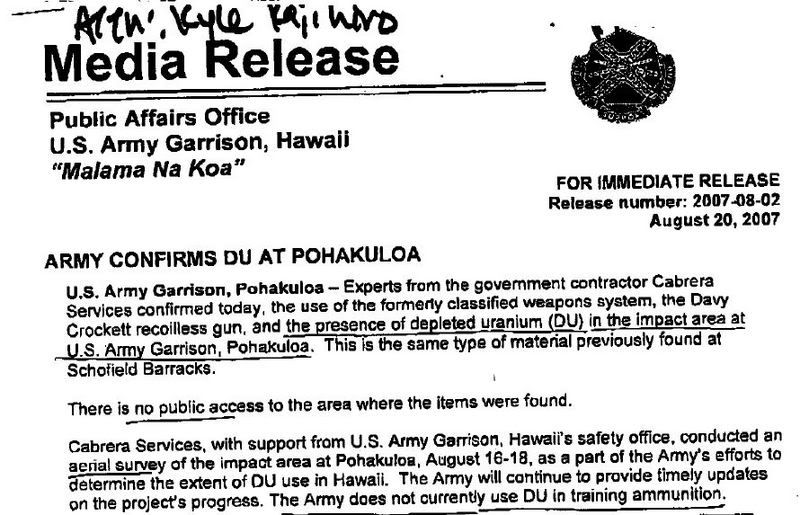
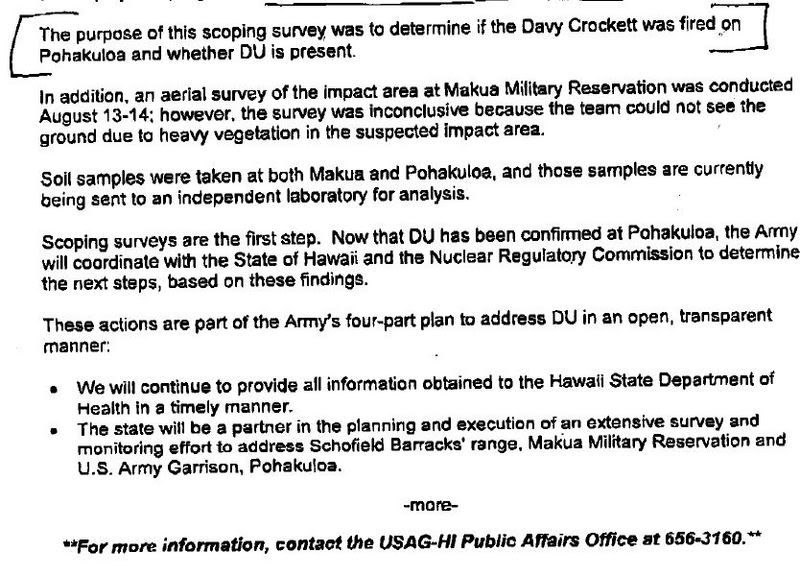
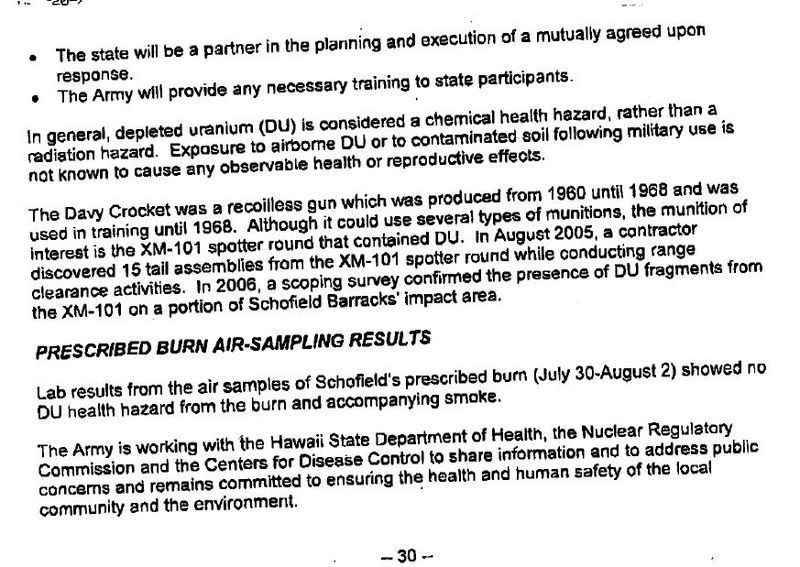


 2008
2008please FORWARD IMMEDIATELY to all ohana & hui...
To all who are concerned about the Taro plant species and all who have kuleana
for Haloa Na Ka Lau Kapalili:
Aia ke ola i ka hana. Life is in labor.
Mahalo pumehana for your efforts to malama Haloa and protect kalo. With a
showing of 800 people in support of taro at the Capitol on opening day of
legislature -and- clear determination to educate ourselves & our communities
-and- organized persistent communication with politicians... your actions made
this happen:
THERE WILL BE A HEARING FOR BILL SB958- the 10 Year Moratorium on Genetic
Modification of Taro! This is joyous & hopeful news!
The hearing will be MARCH 19th, in the morning- Kalo needs much solid support!
If can, try to take off work and bear witness at this historic hearing..
He keiki aloha na mea kanu. Beloved children are the plants.
NOW is the time to express your concern and aloha for kalo in writing!
If you ono for poi, make it official and demand protections for kalo and the
taro industry- which will be permanently impacted by the disrespectful &
irresponsible dangers of GMO kalo.
We all still have the hard work of convincing the politicians to PASS the bill
without inappropriate changes, so please...
SEND YOUR LETTER OF TESTIMONY NOW!
TESTIMONY LETTERS NEEDED BY Thursday, MARCH 6! To show your support & mana'o to
key politicians before the hearing is scheduled.
EMAIL TESTIMONY TO NaKahuOHaloa@gmail.com
If you miss the March 6th deadline please submit testimony to us no later than
March 15th. We will submit all testimony on time for the hearing at the Capitol
on March 19th.
* Write your own testimony if can, personal testimony has much more importance
when the politicians are reviewing all the letters. Or if way too busy, no
worries, just use the sample letter provided BELOW. Be sure to include your
name & contact information.
* Write testimony on professional/organization letterhead if can and attach to
email as a PDF or doc.
* EMAIL TESTIMONY TO NaKahuOHaloa@gmail.com
* Forward this email on and encourage others to write testimony NOW!
You can also print out attached testimony form to pass out for people to write
in their support. Completed forms can be mailed to:
KAHEA: The Hawaiian Environmental Alliance attn. KALO
PO Box 270112 Honolulu, HI 96827
When emailing your letter to NaKahuOHaloa@gmail.com please also CC as a letter
to the editor of the newspapers that have not yet fairly nor accurately
reported on this issue. Just copy these emails into the "CC" address line when
you send us your letter:
letters@honoluluadvertiser.com
letters@starbulletin.com
To Organizations/Businesses/Non-Profits: Please submit your testimony with your
letterhead. If you need further assistance or information for drafting or
submitting testimony please contact us- we can help!
Please be aware of your rights: Non-profits ARE legally allowed to endorse
legislation. Non-profits are NOT allowed to endorse political candidates or
spend more than a certain percentage of budget on lobbying efforts. Submitting
testimony on this legislation will NOT compromise your 501-c-3 status. Contact
KAHEA (kahea-alliance@hawaii.rr.com) for more information.
SEE ATTACHMENTS for more background information on the bill SB958, genetic
modification & kalo, and sample testimony form to print out.
Enjoy the 'artestimony' kindly provided by Solomon Enos, also a kalo farmer-
these inspiring images remind us of the 'big picture' of why we must protect
kalo in Hawaii! but no try sell em ah (;
CALL YOUR ELECTED OFFICIALS-
Tell them to support SB958 for ALL Varieties of Taro in Hawaii!
In case some politicians try to weaken the purpose of the bill, please make it
clear that: This bill must protect ALL varieties of kalo in Hawaii. Not only
the Hawaiian varieties of kalo. Genetic modification of any variety of the taro
plant species is a danger to the entire species and a danger to the purity of
our Hawaiian varieties.
House Representatives Districts/phones/emails:
http://www.capitol.hawaii.gov/site1/house/members/membersasp
Senators Districts/phones/emails:
http://www.capitol.hawaii.gov/site1/senate/members/members.asp
CONTACT NaKahuOHaloa@gmail.com for educational materials & speakers, to
volunteer, or to make a tax deductible donation to this kaloroots movement.
Check www.KAHEA.org for more information- the Haloa page is continually
updated, and soon will feature inspiring examples of testimony from all over
Hawaii!
http://www.kahea.org/gmo/more.php?id=461_0_9_0_C
You can also easily submit your testimony online at KAHEA's Testimony Table:
http://salsa.democracyinaction.org/o/2699/t/3040/campaignjsp?campaign_KEY=22208
Please review www.HawaiiSeed.org for more information on GMOs in Hawaii.
sample TESTIMONY
if can submit to NaKahuOHaloa@gmail.com by Thursday, March 6 please! final
deadline is March 15th.
_________________________________________________
Name:
Organizations:
Neighborhood:
Town, Zip Code:
Phone/Email:
TESTIMONY- IN SUPPORT
SB958- 10 Year Moratorium on the Genetic Modification of Taro
Aloha Legislators,
We write to ask that you support the 10 year moratorium on all forms of genetic
modification and patenting of the taro (kalo) plant species. For 1200 years
farmers in Hawai'i have cared for and protected the most varieties of taro on
the planet. In Hawai'i taro is the plant of the people- it is our living
culture and ancient history, native nutrition and ecological tradition. Taro
provides a beloved and unique hypoallergenic food, medicine, sustainable
agriculture and industry for Hawaii. Genetically modifying any variety of taro
is culturally disrespectful and also poses irreversible and irresponsible
dangers to our food, health, environment and economy.
I support sustainable farming & precautionary scientific research that does not
expose the taro species to the disrespect and risks of genetic engineering. I
ask that the legislators actively support farmers/scientists in publicly
accepted and safely advanced methods of protecting taro from land & water
issues and invasive pests & diseases.
Taro is an incomparably sacred and valuable part of our island community. We
join mahi'ai (farmers) of Hawai'i in calling on you and your fellow legislators
to protect all of us and Hawaii's unique culture and resources by passing a law
to provide a 10 year moratorium on the genetic modification and patenting of
all varieties of the taro plant species.
Malama Haloa! Malama Pono,
______________________________________________
Signature/Name
Email Testimony to:NaKahuOHaloa@gmail.com
Or send to: KAHEA: The Hawaiian Environmental Alliance, Attn. KALO
P.O. Box 270112
Honolulu, HI 96827-0112
MALAMA HALOA! MALAMA PONO!

 Demonstration vs the 3rd Biotech conference in GreeceBioTech Chemical Biological Pharmaceutical WeaponsCRASH'D: Anti-Biotech ProtestorsThe Health Dangers of Genetically Modified FoodsBiopiracy Patents & the Rise of Intellectual ImperialismBy: Mike Adams, www.Naturalnews.com, March 03, 2008It is a defining characteristic of Western civilization that power-hungry men seek to declare ownership over all things they discover. For most of human history, such ownership efforts were focused on usable land. Owning land that could grow food, after all, was a valuable strategy for staying alive. As mechanized farming methods spread, power-hungry white men sought to own and control a labor force -- and so human slavery was pursued.I don't just mean slavery in the U.S., by the way, and it wasn't pursued exclusively by rich white men. World history is rife with nations engaged in routine slavery, from the Roman Empire and ancient Egypt to the not-so-ancient Brazil, where nearly genetically-identical people enslaved each other to work the rich Brazilian soils and produce agricultural profits.From agriculture came the recognition of the value of seeds, and it wasn't long before power-hungry men began patenting the seeds they discovered in nature. Corporations like Monsanto even began performing dark experiments on those seeds, inserting "Terminator" genes that caused second-generation seeds to self-destruct, thereby ensuring their continued ownership and control over those seeds.Now, as the U.S. patent office has allowed corporations to patent life forms and human gene sequences, we are entering a new age where human beings no longer control their own genes. Corporations currently own 20 percent of the human genome, and in the near future, couples who wish to reproduce may be forced to pay intellectual property royalties to wealthy corporations in exchange for the "rights" to copy their own genes through sexual reproduction.His is not some distant dystopian future I'm describing, by the way: This is present-day reality. Corporations are attempting to exert control over everything of value that can possibly be patented, from natural botanical medicines invented by Mother Nature to the very seeds of life found in human DNA. The goal in all this? Complete ownership over the human race and everything of value on the planet.How corporations intend to enslave the human raceIn the future being created by these corporations, you will not only have to pay money to reproduce, you'll also have to pay to grow crops, to fertilize those crops, and to harvest those crops. And once that season is gone, you'll have to pay all over again to buy seeds and pesticides for the next season. Forget about saving seeds or self reliance. The wealthy corporations of the world want the entire population to be dependent on them for food, medicine and even human reproduction. There is no human action that cannot be exploited by corporations for intellectual property claims.The road to totalitarian enslavement is paved with patents...If we continue to allow corporations to claim ownership over our money, our medicines, our seeds, plants and genes, then make no mistake about the outcome: We will all end up as worker slaves in an elitist plutocracy run by corporations. Some say we're close to that already. Just look at how effectively corporate interests now control the U.S. Congress, for example. There's hardly a law passed today that doesn't have the backing of a profit-minded corporation.What's infuriating about the patents currently being awarded to corporations is that most of the things being patented were invented by Mother Nature! Arrogant Man, of course, comes along and claims that he "invented" these things by merely discovering them. It's like walking through a forest, finding a beautiful waterfall, and proclaiming, "I invented this waterfall!" That's what the U.S. patent office allows corporations to do right now with animals, genes, seeds and medicines. The human genome, for example, wasn't "invented" by scientists; it was merely mapped by scientists. It was invented by Mother Nature or God, depending on your particular spiritual or religious beliefs. By what arrogance should Man grant other men patents on the human genome?Stealing from the poor to pay the richDistorted in this way, the patent process followed in the United States is a system whereby the wealthy steal resources from the poor. Instead of a seed belonging to everyone (i.e. "community property"), ownership of that seed is now granted to one entity (a corporation) which can then charge the People for using it. This sort of patenting is nothing more than a fabricated system of ownership that funnels wealth from the hands of the many to the pockets of the few.No wonder U.S. corporations so strongly favor the U.S. patent system. It is the legal machine by which corporations can strong-arm the masses, stealing not only their present resources but also their future wealth, effectively criminalizing farmers and peasants for daring to plant the same seeds they've planted for generations.It is not surprising, then, that this system of patent protection was invented by power-hungry white men. It is the greedy white men who have invaded the world, committed genocide against the American Indians, wiped out ancient civilizations in South America, enslaved Southeast Asia, drugged the Chinese with Opium, colonized India, annexed Hawaii and subjugated defenseless populations all over the world. Can you guess where it all points back to? The British Empire, of course. No single empire has done more to decimate the cultures, religions and populations of this world than the British Empire. And today, the American Empire borrows its own brand of tyranny and imperialism from the historical actions of the British Empire. (America has created the very same tyranny and cruelty it sought to escape hundreds of years ago...)Today, these two English-speaking nations (the U.K. and America) continue to invade the world with their junk foods, pharmaceuticals, soda pop, medical systems and exploitive intellectual property laws. The pushing of patents and intellectual property law onto third world nations amounts to a kind of intellectual imperialism And every nation that embraces Western culture finds itself, usually within one generation, diseased, bankrupt and destitute. Its monies have been stolen and exchanged for endless debt to the International Monetary Fund. Its crops have been replaced with seeds patented by Monsanto. Its cultural foods have been replaced with Western processed junk foods, and its People have been feed lies and propaganda about the "superiority" of Western banking, Western medicine, Western capitalism and Western culture.This is how we wind up with doctors in China denouncing their own Chinese Medicine, or working people in South America giving up eating quinoa and starting to eat fast food hamburgers. The ultimate outcome for these people is not in doubt: Within a few years, they will find themselves diseased and bankrupt, with their natural resources exploited, their crops genetically contaminated and their futures mortgaged to corporations that rule the world.I'm not sure exactly how corporations and patents will play a role in the destruction of Western civilizations. It could be that genetic pollution of our primary food crops causes runaway genetic contamination of corn, wheat and soy, followed by a blight that collapses the food supply (wheat supplies are already down to a 10-week supply for the entire world). Or it could be that financial disaster strikes first, collapsing the fractional-reserve financial institutions and worthless paper currencies that somehow still manages to move the economic machinery of modern society. There are a hundred different reasons why our current systems of consumption, pollution and economics are simply not sustainable -- and it's anyone's guess which one is going to reach the point of implosion first.How we protect our futures and stop the tyranny of intellectual property claims over seeds, genes and medicinesAfter Western society collapses (which will happen in our lifetimes, most likely, given the food bubble, oil bubble, financial bubble, massive chemical contamination, etc.), we will all have an opportunity to rebuild a new society based on new rules. When this opportunity arises, it is crucial that we radically reform intellectual property laws that deny the corporation..s the ability to steal our futures by claiming ownership over genes, seeds and medicines. These things in particular must be protected as being non-patentable so that the People of the world are never driven into poverty by corporate claims over basic life necessities like food and medicine.Much of the Western capitalism model must be thrown out, actually. It is a model that only subsists on the non-stop exploitation of natural resources and human beings. It is a model where everything is disposable, where the next fiscal quarter is more important than the next generation, and where ethics and integrity have absolutely no role. Any nation that trains its future on this model of mass exploitation ultimately has no future.That's why I support the immediate cancellation of all patents on life forms, genes, seeds and medicines. Those who ask, "But what is the incentive for people to create new medicines?" That's an example of limited Western thinking. Greed is not the sole motivator for innovation. Individuals, universities and governments can create new medicines for the benefit of all people. Besides, Nature has already invented nearly all the medicines we really need. All we need to do is propagate those medicines through the mindful planting and harvesting of medicinal plants. And if you really think only drug companies can come up with new medicines that society needs, then ask yourself this question: Why are 80% of all the "new" medicines invented by Big Pharma just "me-too" drugs that work no better than the older drugs with patents that are about to expire? Clearly, the motivation in Big Pharma today is not to create medicines for the benefit of mankind, but to create medicines for the benefit of shareholders.It's time to end the "ownership" of genes, seeds and medicines. These belong to the People. I urge everyone reading this to take part in the movement to end greed-based intellectual property rights and help return our future to our children.-------------------------------------------------------------Related ArticlesBad Patents, Evil Corporations and the Rise of Intellectual ImperialismJunk patents to be revisited by U.S. Supreme Court; ripple effect may be profoundThailand challenges Big Pharma, threatens to further override patents to give Thai people more affordable generic medicineInfluenza virus samples, vaccine patents and corporate liesNovartis sues India over drug patents; seeks to block generic manufacturing by third world nationsThis site is part of the Natural News Network © 2008 All Rights Reserved. Privacy | Terms All content posted on this site is commentary or opinion and is protected under Free Speech. Truth Publishing International, LTD. has full ownership of and takes sole responsibility for all content. Truth Publishing sells no health or nutritional products and earns no money from health product manufacturers or promoters. The information on this site is provided for educational and entertainment purposes only. It is not intended as a substitute for professional advice of any kind. Truth Publishing assumes no responsibility for the use or misuse of this material. Your use of this website indicates your agreement to these terms and those published here. All trademarks, registered trademarks and service marks mentioned on this site are the property of their respective owners.Disclaimer: Posting articles does not necessarily endorse or agree with every opinion expressed in every article. All articles that are posted are aimed at getting people to think & consider the various issues, ideas & factual research presented.Reprinted by permissionPresented by Bill Haymin, 2008mahalo:posted by , Nini'ane
Demonstration vs the 3rd Biotech conference in GreeceBioTech Chemical Biological Pharmaceutical WeaponsCRASH'D: Anti-Biotech ProtestorsThe Health Dangers of Genetically Modified FoodsBiopiracy Patents & the Rise of Intellectual ImperialismBy: Mike Adams, www.Naturalnews.com, March 03, 2008It is a defining characteristic of Western civilization that power-hungry men seek to declare ownership over all things they discover. For most of human history, such ownership efforts were focused on usable land. Owning land that could grow food, after all, was a valuable strategy for staying alive. As mechanized farming methods spread, power-hungry white men sought to own and control a labor force -- and so human slavery was pursued.I don't just mean slavery in the U.S., by the way, and it wasn't pursued exclusively by rich white men. World history is rife with nations engaged in routine slavery, from the Roman Empire and ancient Egypt to the not-so-ancient Brazil, where nearly genetically-identical people enslaved each other to work the rich Brazilian soils and produce agricultural profits.From agriculture came the recognition of the value of seeds, and it wasn't long before power-hungry men began patenting the seeds they discovered in nature. Corporations like Monsanto even began performing dark experiments on those seeds, inserting "Terminator" genes that caused second-generation seeds to self-destruct, thereby ensuring their continued ownership and control over those seeds.Now, as the U.S. patent office has allowed corporations to patent life forms and human gene sequences, we are entering a new age where human beings no longer control their own genes. Corporations currently own 20 percent of the human genome, and in the near future, couples who wish to reproduce may be forced to pay intellectual property royalties to wealthy corporations in exchange for the "rights" to copy their own genes through sexual reproduction.His is not some distant dystopian future I'm describing, by the way: This is present-day reality. Corporations are attempting to exert control over everything of value that can possibly be patented, from natural botanical medicines invented by Mother Nature to the very seeds of life found in human DNA. The goal in all this? Complete ownership over the human race and everything of value on the planet.How corporations intend to enslave the human raceIn the future being created by these corporations, you will not only have to pay money to reproduce, you'll also have to pay to grow crops, to fertilize those crops, and to harvest those crops. And once that season is gone, you'll have to pay all over again to buy seeds and pesticides for the next season. Forget about saving seeds or self reliance. The wealthy corporations of the world want the entire population to be dependent on them for food, medicine and even human reproduction. There is no human action that cannot be exploited by corporations for intellectual property claims.The road to totalitarian enslavement is paved with patents...If we continue to allow corporations to claim ownership over our money, our medicines, our seeds, plants and genes, then make no mistake about the outcome: We will all end up as worker slaves in an elitist plutocracy run by corporations. Some say we're close to that already. Just look at how effectively corporate interests now control the U.S. Congress, for example. There's hardly a law passed today that doesn't have the backing of a profit-minded corporation.What's infuriating about the patents currently being awarded to corporations is that most of the things being patented were invented by Mother Nature! Arrogant Man, of course, comes along and claims that he "invented" these things by merely discovering them. It's like walking through a forest, finding a beautiful waterfall, and proclaiming, "I invented this waterfall!" That's what the U.S. patent office allows corporations to do right now with animals, genes, seeds and medicines. The human genome, for example, wasn't "invented" by scientists; it was merely mapped by scientists. It was invented by Mother Nature or God, depending on your particular spiritual or religious beliefs. By what arrogance should Man grant other men patents on the human genome?Stealing from the poor to pay the richDistorted in this way, the patent process followed in the United States is a system whereby the wealthy steal resources from the poor. Instead of a seed belonging to everyone (i.e. "community property"), ownership of that seed is now granted to one entity (a corporation) which can then charge the People for using it. This sort of patenting is nothing more than a fabricated system of ownership that funnels wealth from the hands of the many to the pockets of the few.No wonder U.S. corporations so strongly favor the U.S. patent system. It is the legal machine by which corporations can strong-arm the masses, stealing not only their present resources but also their future wealth, effectively criminalizing farmers and peasants for daring to plant the same seeds they've planted for generations.It is not surprising, then, that this system of patent protection was invented by power-hungry white men. It is the greedy white men who have invaded the world, committed genocide against the American Indians, wiped out ancient civilizations in South America, enslaved Southeast Asia, drugged the Chinese with Opium, colonized India, annexed Hawaii and subjugated defenseless populations all over the world. Can you guess where it all points back to? The British Empire, of course. No single empire has done more to decimate the cultures, religions and populations of this world than the British Empire. And today, the American Empire borrows its own brand of tyranny and imperialism from the historical actions of the British Empire. (America has created the very same tyranny and cruelty it sought to escape hundreds of years ago...)Today, these two English-speaking nations (the U.K. and America) continue to invade the world with their junk foods, pharmaceuticals, soda pop, medical systems and exploitive intellectual property laws. The pushing of patents and intellectual property law onto third world nations amounts to a kind of intellectual imperialism And every nation that embraces Western culture finds itself, usually within one generation, diseased, bankrupt and destitute. Its monies have been stolen and exchanged for endless debt to the International Monetary Fund. Its crops have been replaced with seeds patented by Monsanto. Its cultural foods have been replaced with Western processed junk foods, and its People have been feed lies and propaganda about the "superiority" of Western banking, Western medicine, Western capitalism and Western culture.This is how we wind up with doctors in China denouncing their own Chinese Medicine, or working people in South America giving up eating quinoa and starting to eat fast food hamburgers. The ultimate outcome for these people is not in doubt: Within a few years, they will find themselves diseased and bankrupt, with their natural resources exploited, their crops genetically contaminated and their futures mortgaged to corporations that rule the world.I'm not sure exactly how corporations and patents will play a role in the destruction of Western civilizations. It could be that genetic pollution of our primary food crops causes runaway genetic contamination of corn, wheat and soy, followed by a blight that collapses the food supply (wheat supplies are already down to a 10-week supply for the entire world). Or it could be that financial disaster strikes first, collapsing the fractional-reserve financial institutions and worthless paper currencies that somehow still manages to move the economic machinery of modern society. There are a hundred different reasons why our current systems of consumption, pollution and economics are simply not sustainable -- and it's anyone's guess which one is going to reach the point of implosion first.How we protect our futures and stop the tyranny of intellectual property claims over seeds, genes and medicinesAfter Western society collapses (which will happen in our lifetimes, most likely, given the food bubble, oil bubble, financial bubble, massive chemical contamination, etc.), we will all have an opportunity to rebuild a new society based on new rules. When this opportunity arises, it is crucial that we radically reform intellectual property laws that deny the corporation..s the ability to steal our futures by claiming ownership over genes, seeds and medicines. These things in particular must be protected as being non-patentable so that the People of the world are never driven into poverty by corporate claims over basic life necessities like food and medicine.Much of the Western capitalism model must be thrown out, actually. It is a model that only subsists on the non-stop exploitation of natural resources and human beings. It is a model where everything is disposable, where the next fiscal quarter is more important than the next generation, and where ethics and integrity have absolutely no role. Any nation that trains its future on this model of mass exploitation ultimately has no future.That's why I support the immediate cancellation of all patents on life forms, genes, seeds and medicines. Those who ask, "But what is the incentive for people to create new medicines?" That's an example of limited Western thinking. Greed is not the sole motivator for innovation. Individuals, universities and governments can create new medicines for the benefit of all people. Besides, Nature has already invented nearly all the medicines we really need. All we need to do is propagate those medicines through the mindful planting and harvesting of medicinal plants. And if you really think only drug companies can come up with new medicines that society needs, then ask yourself this question: Why are 80% of all the "new" medicines invented by Big Pharma just "me-too" drugs that work no better than the older drugs with patents that are about to expire? Clearly, the motivation in Big Pharma today is not to create medicines for the benefit of mankind, but to create medicines for the benefit of shareholders.It's time to end the "ownership" of genes, seeds and medicines. These belong to the People. I urge everyone reading this to take part in the movement to end greed-based intellectual property rights and help return our future to our children.-------------------------------------------------------------Related ArticlesBad Patents, Evil Corporations and the Rise of Intellectual ImperialismJunk patents to be revisited by U.S. Supreme Court; ripple effect may be profoundThailand challenges Big Pharma, threatens to further override patents to give Thai people more affordable generic medicineInfluenza virus samples, vaccine patents and corporate liesNovartis sues India over drug patents; seeks to block generic manufacturing by third world nationsThis site is part of the Natural News Network © 2008 All Rights Reserved. Privacy | Terms All content posted on this site is commentary or opinion and is protected under Free Speech. Truth Publishing International, LTD. has full ownership of and takes sole responsibility for all content. Truth Publishing sells no health or nutritional products and earns no money from health product manufacturers or promoters. The information on this site is provided for educational and entertainment purposes only. It is not intended as a substitute for professional advice of any kind. Truth Publishing assumes no responsibility for the use or misuse of this material. Your use of this website indicates your agreement to these terms and those published here. All trademarks, registered trademarks and service marks mentioned on this site are the property of their respective owners.Disclaimer: Posting articles does not necessarily endorse or agree with every opinion expressed in every article. All articles that are posted are aimed at getting people to think & consider the various issues, ideas & factual research presented.Reprinted by permissionPresented by Bill Haymin, 2008mahalo:posted by , Nini'ane

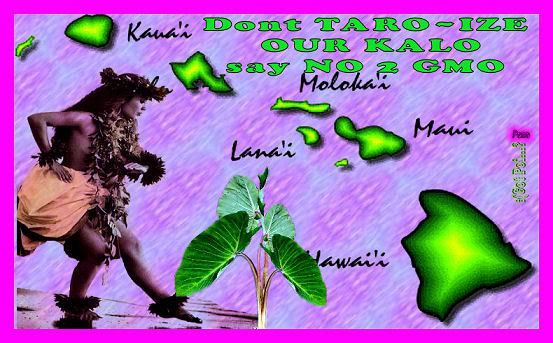
 GMO taro bill moves forwardby Rachel Gehrlein - THE GARDEN ISLAND, March 4, 2008Would put moratorium on developing GMO strainsSupporters of a Senate bill aimed to impose a 10-year moratorium on the developing, testing and raising of genetically modified taro are relieved, after waiting for more than a year, that the bill will be heard on March 19.After Senate Bill 958 was first introduced in January 2007 it failed but was carried over to the 2008 legislative session.“We were very stubborn telling them (lawmakers) the bill needs to be heard,” said Chris Kobayashi, a Kaua‘i taro farmer. “The 10-year moratorium is just a time out so things could be explored further.”Jeri DiPietro of GMO Free Kaua‘i agrees.“(The bill) asks for a temporary moratorium, a time out,” DiPietro said.“It is a moment to evaluate and use precaution in a new situation. If only a second look had been given before the Department of Agriculture allowed the importation of the apple snail and let it rage out of control into pest status.”Kobayashi said the idea of GMO taro is scary because on the genetic level, if the taro is modified from the original plant, “we can never bring it back.”“As farmers, we wouldn’t be able to see the difference,” Kobayashi said. “There is a lot of sharing of huli (the starts of taro) between farmers.”Rep. Mina Morita, D-Kapa‘a-North Kaua‘i, said taro is a food crop that has cultural implications that scientists need to be aware of.“The scientists should be responsible to the individual,” Morita said. “If individuals think GMO research is not necessary at this time, and the farmers don’t want to grow it and the consumers don’t want to eat it, who does it benefit?”Wayne Nishijima, associate dean with the University of Hawai‘i’s College of Tropical Agriculture and Human Resources, said the university signed an agreement with the Royal Order of Kamehameha I a few years ago to not conduct GMO tests on known Hawaiian varieties of taro.But Nishijima said the Hawaiian taro’s susceptibility to various pests, such as Phytophthora colocasiae — a fungus-like organism that invaded American Samoa taro in 1993 — could be solved with genetic engineering.“The current GE project (at UH) is on Chinese taro to develop resistant varieties to Phytophthora blight,” Nishijima said. “No Hawaiian varieties have been genetically engineered, but we have researchers doing traditional breeding to develop Phytophthora resistant cultivars, but it takes time.”But because none of the Hawaiian varieties have Phytophthora resistance, taro from other locales must be used, Nishijima said.Nishijima feels that because UH has already signed a moratorium, there is no need for a law to be passed to create another moratorium.“In my opinion, extending the moratorium to include genetic engineering of non-Hawaiian taro varieties does not follow their argument of infringement of their cultural rights and heritage,” Nishijima said. “What it will do is significantly limit our ability to address current and future problems. If the bill passes, it will put taro in a position to make it vulnerable to the devastation by new invasive species.”In support of SB 958 imposing the moratorium, the Kaua‘i County Council has drafted Resolution 2008-04. The resolution is scheduled to be heard at the council meeting on March 12.“We need as many testimonies as is possible to support SB 958,” DiPietro said in an e-mail. “You need not be a farmer. Consumers have a right to a choice too.”GMO Free Kaua‘i will also hold a rally in support of the SB 958 today from 4 to 6 p.m. at the gateway at Lihu‘e Airport.• Rachel Gehrlein, staff writer, can be reached at 245-3681 (ext. 225) or rgehrlein@kauaipubco.com.Mahalo, Posted by: Nini'ane
GMO taro bill moves forwardby Rachel Gehrlein - THE GARDEN ISLAND, March 4, 2008Would put moratorium on developing GMO strainsSupporters of a Senate bill aimed to impose a 10-year moratorium on the developing, testing and raising of genetically modified taro are relieved, after waiting for more than a year, that the bill will be heard on March 19.After Senate Bill 958 was first introduced in January 2007 it failed but was carried over to the 2008 legislative session.“We were very stubborn telling them (lawmakers) the bill needs to be heard,” said Chris Kobayashi, a Kaua‘i taro farmer. “The 10-year moratorium is just a time out so things could be explored further.”Jeri DiPietro of GMO Free Kaua‘i agrees.“(The bill) asks for a temporary moratorium, a time out,” DiPietro said.“It is a moment to evaluate and use precaution in a new situation. If only a second look had been given before the Department of Agriculture allowed the importation of the apple snail and let it rage out of control into pest status.”Kobayashi said the idea of GMO taro is scary because on the genetic level, if the taro is modified from the original plant, “we can never bring it back.”“As farmers, we wouldn’t be able to see the difference,” Kobayashi said. “There is a lot of sharing of huli (the starts of taro) between farmers.”Rep. Mina Morita, D-Kapa‘a-North Kaua‘i, said taro is a food crop that has cultural implications that scientists need to be aware of.“The scientists should be responsible to the individual,” Morita said. “If individuals think GMO research is not necessary at this time, and the farmers don’t want to grow it and the consumers don’t want to eat it, who does it benefit?”Wayne Nishijima, associate dean with the University of Hawai‘i’s College of Tropical Agriculture and Human Resources, said the university signed an agreement with the Royal Order of Kamehameha I a few years ago to not conduct GMO tests on known Hawaiian varieties of taro.But Nishijima said the Hawaiian taro’s susceptibility to various pests, such as Phytophthora colocasiae — a fungus-like organism that invaded American Samoa taro in 1993 — could be solved with genetic engineering.“The current GE project (at UH) is on Chinese taro to develop resistant varieties to Phytophthora blight,” Nishijima said. “No Hawaiian varieties have been genetically engineered, but we have researchers doing traditional breeding to develop Phytophthora resistant cultivars, but it takes time.”But because none of the Hawaiian varieties have Phytophthora resistance, taro from other locales must be used, Nishijima said.Nishijima feels that because UH has already signed a moratorium, there is no need for a law to be passed to create another moratorium.“In my opinion, extending the moratorium to include genetic engineering of non-Hawaiian taro varieties does not follow their argument of infringement of their cultural rights and heritage,” Nishijima said. “What it will do is significantly limit our ability to address current and future problems. If the bill passes, it will put taro in a position to make it vulnerable to the devastation by new invasive species.”In support of SB 958 imposing the moratorium, the Kaua‘i County Council has drafted Resolution 2008-04. The resolution is scheduled to be heard at the council meeting on March 12.“We need as many testimonies as is possible to support SB 958,” DiPietro said in an e-mail. “You need not be a farmer. Consumers have a right to a choice too.”GMO Free Kaua‘i will also hold a rally in support of the SB 958 today from 4 to 6 p.m. at the gateway at Lihu‘e Airport.• Rachel Gehrlein, staff writer, can be reached at 245-3681 (ext. 225) or rgehrlein@kauaipubco.com.Mahalo, Posted by: Nini'ane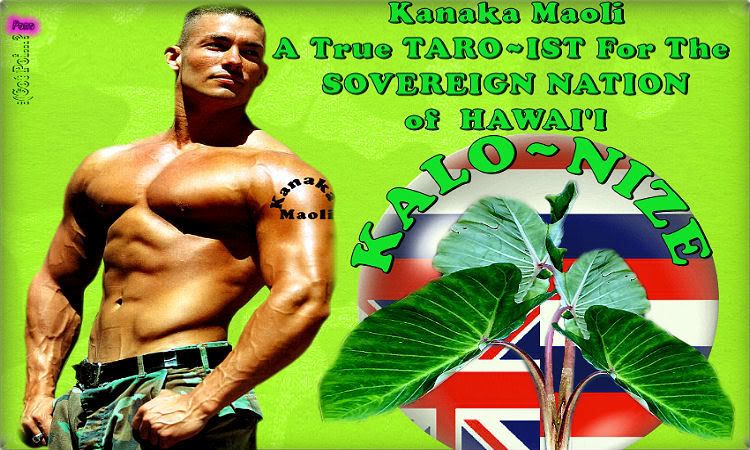

 If you don't know me already, just be observant and you'll see me in a sky near you!I have been persistent in the skys of beautiful new zealand for a few years now, as well as many other area's of the world.If you see me, don't be scared, you know the government wouldn't hurt you, or lie to youThese "tracks" in the skies, left by a combination of military and civilian aircraft drawn into the massive, multi-billion dollar program, are unlike regular high-flying aircraft's vapor trails. Instead of dissipating rapidly, these so-called "chemtrails" mesh together for hours and are often mistaken for natural clouds.Chemicals sprayed into the atmosphere are producing air and ground conditions that may be harmful to humans and animals, while stimulating the growth of molds and bacteria. Barium salts, an Earth metal, are toxins that absorb readily into the gastrointestinal tract which are deposited into muscles and other tissue. No case data is available on the long-term effects of barium in humans."The programs remain secret because the Environmental Protection Agency and state environmental agencies need 'not know' about the by-products of the metabolites of these biological, illegal and harmful agents," said one of the researchers. "It's for that reason the combined projects have been kept secret from the citizens."Since aluminum has been discussed in relationship to the possible components of chemtrails, I thought it was important to give you information about the side effects.HOW ALUMINUM AFFECTS HEALTH* Nervous System - in animal studies, aluminum blocks the action potential or ELECTRICAL DISCHARGE OF NERVE CELLS, REDUCING NERVOUS SYSTEM ACTIVITY.Aluminum also inhibits important enzymes in the brain (Na-K-ATPase and hexokinase). Aluminum may also inhibit uptake of important chemicals by nerve cells (dopamine, norepinephrine, and 5-hydroxytryptamine).* Behavioral Effects - dementia resulting from kidney dialysis related to aluminum toxicity causes memory loss, loss of coordination, confusion and disorientation.* Digestive System - aluminum reduces intestinal activity, and by doing so can cause colic.POSSIBLE CONDITIONS ASSOCIATED WITH ALUMINUM TOXICITY* Early symptoms of aluminum toxicity include: flatulence, headaches, colic, dryness of skin and mucous membranes, tendency for colds, burning pain in head relieved by food, heartburn and an aversion to meat.* Later symptoms include paralytic muscular conditions, loss of memory and mental confusion.OTHER POSSIBLE CONDITIONS ASSOCIATED WITH ALUMINUM TOXICITY* Alzheimer's disease, hypoparathyroidism, amyotrophic lateral sclerosis, anemia, kidney dysfunction, liver dysfunction, hemolysis, Ceukocytosis, porphyria, colitis, neuromuscular disorders, osteomalacia, dental cavities, Parkinson's disease, dementia dialactica, and ulcers.If you are experiencing these disorders, contact a doctor familiar with tests for metals and DMPS IV (intravenous) chelation.I'd like to meet someone that can tell me the truth.Cellphone Towers??? ELF Towers!!! These ugly things have been popping up everywhere, and my phone reception was fine before they put any of them up. Have you been feeling tired? getting headaches? mild flu that won't go away? Cancer? Did you know that your 3G mobile operates at the same frequency as a microwave oven???
If you don't know me already, just be observant and you'll see me in a sky near you!I have been persistent in the skys of beautiful new zealand for a few years now, as well as many other area's of the world.If you see me, don't be scared, you know the government wouldn't hurt you, or lie to youThese "tracks" in the skies, left by a combination of military and civilian aircraft drawn into the massive, multi-billion dollar program, are unlike regular high-flying aircraft's vapor trails. Instead of dissipating rapidly, these so-called "chemtrails" mesh together for hours and are often mistaken for natural clouds.Chemicals sprayed into the atmosphere are producing air and ground conditions that may be harmful to humans and animals, while stimulating the growth of molds and bacteria. Barium salts, an Earth metal, are toxins that absorb readily into the gastrointestinal tract which are deposited into muscles and other tissue. No case data is available on the long-term effects of barium in humans."The programs remain secret because the Environmental Protection Agency and state environmental agencies need 'not know' about the by-products of the metabolites of these biological, illegal and harmful agents," said one of the researchers. "It's for that reason the combined projects have been kept secret from the citizens."Since aluminum has been discussed in relationship to the possible components of chemtrails, I thought it was important to give you information about the side effects.HOW ALUMINUM AFFECTS HEALTH* Nervous System - in animal studies, aluminum blocks the action potential or ELECTRICAL DISCHARGE OF NERVE CELLS, REDUCING NERVOUS SYSTEM ACTIVITY.Aluminum also inhibits important enzymes in the brain (Na-K-ATPase and hexokinase). Aluminum may also inhibit uptake of important chemicals by nerve cells (dopamine, norepinephrine, and 5-hydroxytryptamine).* Behavioral Effects - dementia resulting from kidney dialysis related to aluminum toxicity causes memory loss, loss of coordination, confusion and disorientation.* Digestive System - aluminum reduces intestinal activity, and by doing so can cause colic.POSSIBLE CONDITIONS ASSOCIATED WITH ALUMINUM TOXICITY* Early symptoms of aluminum toxicity include: flatulence, headaches, colic, dryness of skin and mucous membranes, tendency for colds, burning pain in head relieved by food, heartburn and an aversion to meat.* Later symptoms include paralytic muscular conditions, loss of memory and mental confusion.OTHER POSSIBLE CONDITIONS ASSOCIATED WITH ALUMINUM TOXICITY* Alzheimer's disease, hypoparathyroidism, amyotrophic lateral sclerosis, anemia, kidney dysfunction, liver dysfunction, hemolysis, Ceukocytosis, porphyria, colitis, neuromuscular disorders, osteomalacia, dental cavities, Parkinson's disease, dementia dialactica, and ulcers.If you are experiencing these disorders, contact a doctor familiar with tests for metals and DMPS IV (intravenous) chelation.I'd like to meet someone that can tell me the truth.Cellphone Towers??? ELF Towers!!! These ugly things have been popping up everywhere, and my phone reception was fine before they put any of them up. Have you been feeling tired? getting headaches? mild flu that won't go away? Cancer? Did you know that your 3G mobile operates at the same frequency as a microwave oven???



 2 hours later
2 hours later 3 hours later
3 hours later Towerz
Towerz

 RE: Chemtrail pics from OklahomaI live in Tahlequah, Oklahoma east of Tulsa about 70 miles. The area is rural and way off commercial or military flight patterns. We get this crap about 3 times a week. These picks were taken about 2 hours after the attack started over our University community of about 15,000 gentle and innocent souls trying their best to get along peacefully.
RE: Chemtrail pics from OklahomaI live in Tahlequah, Oklahoma east of Tulsa about 70 miles. The area is rural and way off commercial or military flight patterns. We get this crap about 3 times a week. These picks were taken about 2 hours after the attack started over our University community of about 15,000 gentle and innocent souls trying their best to get along peacefully. 
Some of these pictures were taken from the front porch of my state senator, The honorable James Wilson. He still doesn't have a clue as to what they are or why they are being dispersed. For the 4th time I made him witness this apocalyptic tableau in the skies above where his deeply compromised 4 year old grandson plays. As in every case, I pleaded with him to Google "chemtrails" for pages, articles and videos to help him identify the reason behind them and the imminent threat they present to all of us.

I drug several of my very highly educated and intelligent associates outside to see them and their universal response was to look up, scan the panorama and act as if they were seeing the same old sky as always...almost no impression that anything was wrong! Once again, not a single fucking clue! Friends, we are in a world of shit! I feel more and more like Chicken Little every day!
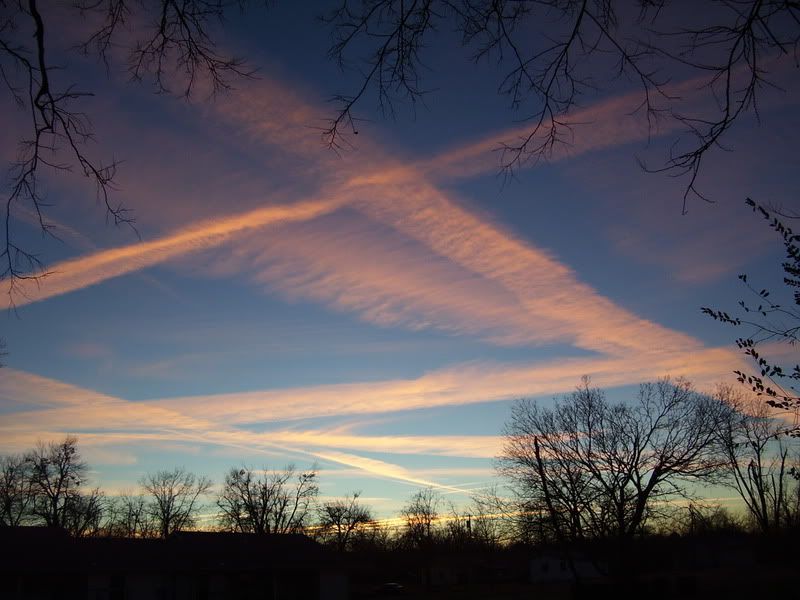
These very limited views were all taken from two yards next to each other, mine and his. They don't even begin to tell the story. These clouds of death extended across the entire county where I live....a huge area!

There were four separate planes going back and fourth continuously for over 2 hours as of the time these pics were taken between 5 and 5:20 PM today, 1/09/08. Anyone else got chemtrails today?





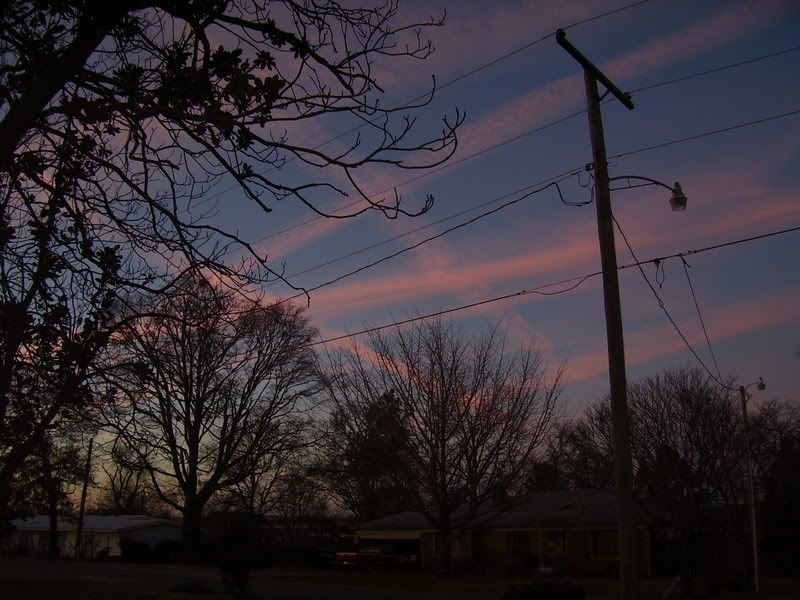





The video today gained widespread attention and condemnation on the Internet.
"The video is shocking and deplorable and is contrary to the high standards we expect of every Marine," the Kane'ohe Bay base said in a release.
Base officials said the video came to their attention this morning. An investigation has been initiated. Maj. Chris Perrine, a Marine spokesman here, said "it's looking like" the Marine is based out of Hawai'i.
"We do not tolerate this type of behavior and will take appropriate action," the base said.
Two Marines are seen in combat gear smiling as one holds a white-and-black puppy by the scruff of its neck. The dog seems to be about 8 weeks old and is motionless as it is held.
"Cute little puppy, huh?" says one Marine as he smiles broadly.
"Oh so cute, so cute, little puppy," says another in a child-like voice.
The Marine holding the puppy is then seen throwing the animal overhand into a desert-like gully below. The animal yelps until it thuds to the ground at the bottom of the gully.
"That's mean," one Marine says afterward.
The 2nd Battalion, 3rd Marine Regiment of about 1,000 Hawai'i Marines recently replaced a sister unit in Iraq, the 3rd Battalion, 3rd Marine Regiment.
Marine Corps Base Hawai'i said the vast majority of Marines "conduct their duties in an honorable manner that brings great credit upon the Marine Corps and the United States."
There have been numerous stories of Marines adopting pets and bringing them home from Iraq or helping to arrange life-saving medical care for Iraqi children. Those are the stories that exemplify what we stand for and how most Marines behave."
The video was posted on YouTube. Caution, graphic content.
Mahalo:Vance...what a goddamned circusIIAloha `aina,
The ceded lands bill controversy continued for another week with the Office of Hawaiian Affairs trying their best to convince Hawaiians it’s a good deal.
But people are not that easily fooled.
It’s never a good deal when you’re talking about stolen property to begin with.
As one testifier stated, “The proposed changes to the law and transfer of certain land and money assets keeps the status quo of State control of the “ceded lands” (through the state agency, OHA), while pretending to have made compensation for the stolen lands.
The State’s solution for stealing a Kingdom is to generously give it to itself!”
Well, there’s still plenty of opportunity to let your legislators know how you feel about this ridiculous proposal.
Be sure and watch Free Hawai`i TV this Wednesday to find out how you can make you voice heard.
This bill can be defeated, but it’s up to you to use your influence now.
And if you support our issues on the Free Hawai`i Broadcasting Network, please email this to a friend and see below how you can help us continue our work.
We debut a brand new show this week with Aunty Pele Hanoa of Punalu`u on Hawai`i island.
She’s a true inspiration, caring for her ancestral lands and protecting them from those whose only desire is to make money and lots of it from Hawaiian lands.
We’re honored to bring you Aunty Pele’s story - an example of people who love their land this week on Voices Of Truth – One-On-One With Hawai`i’s Future.
MONDAY, March 3rd At 7:00 PM & FRIDAY, March 7th At 5:30 PM – Hawai`i Island – Na Leo, Channel 53
TUESDAY, March 4th At 6:30 PM & WEDNESDAY, March 5th At 6:30 AM – Maui – Akaku, Channel 53
THURSDAY, March 6th At 8:30 PM & FRIDAY, March 7th At 8:30 AM – Kaua`i – Ho`ike, Channel 52
“Hidden In The Forest – A Visit With Dr. Baron Kaho`ola Ching”
Deep in a rain forest in Nu`uanu Valley sits one of the most remarkable sites in all Hawai`i.
Imagine a place lost in time and space to the modern world – Kaniakapupu.
A palatial summer residence for Kauikeaoli, Kamehameha III, Kaniakapupu was built over one hundred seventy years ago spanning twenty thousand acres.
Ka La Ho`i Ho`i Ea, Sovereignty Restoration Day, was celebrated on the site in 1843 with over ten thousand guests attending.
Several key documents in Hawaiian history were drafted there and many of Hawai`i’s future rulers visited the residence as children.
Then time swallowed up and forgot Kaniakapupu until one day a few years back Baron cut through thick bamboo forests to rediscover it for himself.
What he saw stopped him in his tracks.
Since then, Baron has overseen the caretaking of this astounding place that time forgot.
Whatever you do, don’t miss our visit with Baron to Kaniakapupu. One of the most unique places in all of Hawai`i, you’ll go with us hiking through dense rain forest as we come face to face ourselves with the ancient residence and artifacts left untouched for almost two centuries in this incredible voyage of rediscovery that is sure to take your breath away.
SATURDAY, March 8th At 8:00 PM – O`ahu - `Olelo, Channel 53
“Eyes Of The Kupuna – A Visit With Aunty Pele Hanoa”
Imagine living next to a beautiful black sands beach, a place you’ve lived your entire life.
Nature is at your door. The ocean, the beach, endangered turtles use the area coming ashore to breed.
Now also imagine tour buses pulling up next to your home and brining one thousand tourists a day. That’s right, one thousand tourists every single day.
Tourists who harass the turtles, steal the sand for souvenirs, leave litter, and behave obnoxiously.
How would you like to put up with that every day of your life?
Aunty Pele does.
Born and raised in Punalu`u, she’s a prime example of old Hawai`i - staying on the land where you were born, because you were taught from an early age to malama the `aina – care for your ancestral land.
All around her things are changing – and not for the better. Multi-national corporations building developments on the shore and then stealing the water from agricultural lands for their projects.
Yet none of this stops her.
Be sure and catch our visit with Aunty Pele. You’ll be as inspired as we were by this remarkable kupuna who stops at nothing and whose message is one you’ll long remember – “We accepted everyone who came to Hawai`i. Now they should reciprocate by protecting and caring for what we have.”
Voices Of Truth interviews those creating a better future for Hawai`i to discover what made them go from armchair observers to active participants in the hopes of inspiring viewers to do the same.
Please consider a donation today to help further our work. Every single penny counts.
You may donate via PayPal at VoicesOfTruthTV.com or by mail –
The Koani Foundation
PO Box 1878
Lihu`e, Kaua`i 96766
If you missed a show, want you see your favorites again or you don’t live in Hawai`i, here’s how to view our shows anytime – visit VoicesOfTruthTV.com and simply click on the episodes you wish to view.
And for news on issues that affect you, watch FreeHawaiiTV.com.
Ho`oku`oko`a,
`Ehu Kekahu Cardwell
The Koani Foundation
Visit www.FreeHawaii.Info
Watch www.FreeHawaiiTV.com
“Voices Of Truth” now online - www.VoicesOfTruthTV.com
The Free Hawai`i Broadcasting Network




